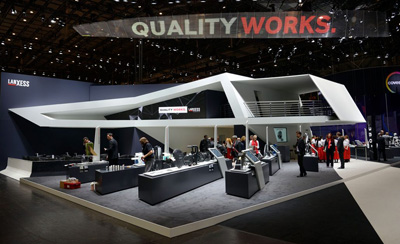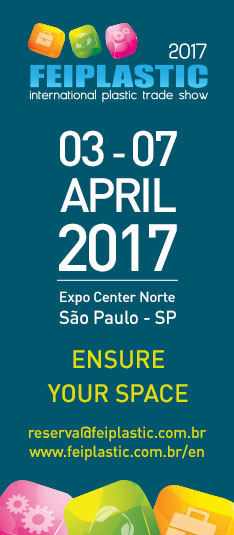| Plastics News |
“Quality Works”: Lanxess´ theme for K2016
October 19, 2016 – From October 19 to 26, Lanxess is exhibiting in Düsseldorf at K 2016, the world’s largest trade fair for plastics and rubber, and its theme for the event is “Quality Works”. At stand C76/C78, extending over some 700 square meters in Hall 6, the specialty chemicals company is presenting its latest developments in materials, processes and technologies for premium plastics and high-performance additives for processing. Also on display are color pigments and intermediates for the polymer industry. “The theme of the exhibition reflects Lanxess’s mission to manufacture high-quality products, deliver powerful answers to the challenges facing international markets, and supply the right solutions to customers to meet their diverse needs,” says Dr. Hubert Fink, member of the Board of Management of Lanxess AG. Environmentally friendly lightweight solutions for the automotive industry “In one area of the exhibit, Lanxess is showing high-performance plastics for a variety of applications that promote the mobility of the future. The focus is on innovative, resource-saving and environmentally friendly lightweight solutions, because lightweight materials and technologies can reduce weight in virtually every part of a motor vehicle. And plastics are essential to these solutions,” says Dr. Michael Zobel, Head of the Lanxess High Performance Materials business unit. Depending on the demands made on the part in question, engineering plastics can entirely replace comparatively heavy metal parts or be combined with other materials. The weight of individual components can be reduced in this way without adversely affecting other physical properties, such as mechanical strength. As one of many examples of lightweight applications, Lanxess will be exhibiting an oil pan module made of Durethan BKV 30 H2.0 (PA 6) for the Porsche 911 Carrera. This highly complex component satisfies all the specific requirements imposed on the new-generation engine in terms of weight reduction, function integration and cost-efficient production. Durable and lightweight: Semi-finished composites Tepex-brand fiber composites are predestined for lightweight applications. The core components of this material are state-of-the-art thermoplastics reinforced with continuous fibers, such as glass or carbon, depending on the field of application. The material and the associated processing technologies are now ready for use in full-scale production. Tepex therefore is ideally suited to mass production settings, such as automotive manufacturing. At the trade fair, Lanxess has a prominent example of Tepex on show: an all-plastic brake pedal installed in the Porsche Panamera NF and Bentley Continental GT. Tepex is also ideal for fabricating virtually indestructible engine compartment trim, fuel tank covers and center tunnel covers, like those already in use in several standard car models, such as the Bentley Bentayga SUV. These continuous-fiber-reinforced thermoplastic composites likewise are suitable for manufacturing very stiff, strong, thin-walled components, such as device mounts with high functional integration, versions of which are already in use in several standard car models. Trade fair visitors can see just how such a prototype component is manufactured with an optimized cycle time in demonstrations at the KraussMaffei Technologies GmbH stand. Leonard Kurz Stiftung & Co. KG and Bond-Laminates GmbH have developed a new material combination and the associated mold technology for fabricating finished, decorated housing components with extremely thin walls in just one processing step. The process starts with a Tepex dynalite semi-finished thermoplastic composite. It is formed in an injection mold, back-injected, and then decorated inline using an in-mold decoration integration process specially developed for this purpose, an advancement over Kurz's existing in-mold process. It incorporates a transfer coating system. Engel Austria GmbH engineered a highly automated manufacturing cell for the new material combination that is suited to large-scale production. The new manufacturing process from Kurz and Bond-Laminates is being demonstrated live for the first time at Engel's stand; the demo part is a housing component. Products for athletic equipment, such as soccer shoes, ski boots, bicycle parts and golf club components, likewise benefit from the significant weight advantages of this lightweight material. E/E applications on the rise The use of thermoplastics in the electrical/electronics sector (E&E) will continue to grow strongly in the future thanks to megatrends such as Industry 4.0, LED lighting and the digital networking of building systems, household appliances and entertainment electronics. Lanxess’s High Performance Materials (HPM) business unit – a world-leading supplier of compounds based on polyamide 6, polyamide 66 and polybutylene terephthalate (PBT) with its Durethan and Pocan brands – is therefore boosting its activities for the E&E industry. A new E&E Marketing and Sales segment has been set up that pools resources for this industries and organizes them in more targeted fashion. Areas of focus on the product side include thermoplastics with good melt flow characteristics that facilitate the design of large, thin-walled components of complex geometry. One example is a roller support for a food processor from a premium household appliance manufacturer. It is made of Pocan C 3230 XF (XtremeFlow). With this material, the precision component, which is subjected to high mechanical stress, can be of thin design, but still display low warpage and high dimensional stability. Other new products from HPM include hydrolysis-stabilized PBT compounds for automotive electrical and electronic systems and thermally conductive polyamides. High-performance materials for electric mobility Electric mobility is gaining significance in the plastics industry. Regarding materials, electrical properties and flame retardance, and also electromagnetic compatibility, are some of the main requirements. These often go hand-in-hand with a need for very good mechanical properties. For instance, Pocan AF 4110 is particularly suitable for electric cars on account of its high flame retardance. The Italian company Askoll e.g. uses the material to fabricate battery cell housings for its electric scooters. It replaces a material solution based on a polycarbonate/ABS blend. The Lanxess material was selected not only because of its low warpage and high flame retardance, but also because it meets the strict requirements on chemical resistance, thermal stability and impact strength. What’s more, it can also be ultrasonically welded in a stable process. Customized additives for the plastics and rubber industry The Lanxess Rhein Chemie Additives business unit is showcasing products from its extensive line of additives, such as predispersed cellulose fiber and aramid short-fiber masterbatches. They offer rubber processors a wide variety of reinforcement options for different requirements and applications, ranging from hoses, conveyor belts and timing belts to ultra-high-performance and special-purpose tires. The predispersion of various fiber pulps in special polymer matrices enables good miscibility and homogeneous distribution in the rubber compound. Only by being fully dispersed can the fiber pulp have its complete impact and achieve an optimal reinforcement effect in the end product. Lanxess brings color to the world of polymers Colored plastics are becoming increasingly widespread and the number of applications is rising continuously. However, the pigments must satisfy a number of exacting requirements. Given the short dwell times and relatively low shear forces in customer processes, they must display good dispersibility i.e. they must be easy to distribute so as to reach their final tinting strength quickly. They must display high thermal stability, no migration and sufficient levels of lightfastness and weather stability for the intended application. Colortherm iron and chromium oxide pigments from Lanxess’s Inorganic Pigments business unit meet these requirements in full. What’s more, they are easy to process and their special micronization allows for high throughput, because the very finely ground pigments disperse quickly in a plastic. The U.S. Food and Drug Administration (FDA) has licensed the environmental friendly and safe pigments from the Colortherm range as a raw material for coloring toys and food packaging. Source: Lanxess |


